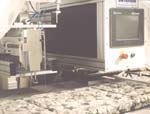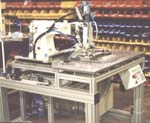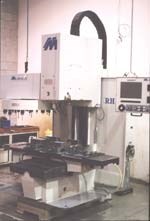ERP System Keeps New Work Center Fully Loaded
It's difficult for a small, specialized machine builder doing $1.5 million in sales annually to buy a $100,000 machine tool, then keep it fully loaded and realize a good return on investment without upsetting the workload throughout the shop—especially with the current manufacturing slowdown.
Share





It's difficult for a small, specialized machine builder doing $1.5 million in sales annually to buy a $100,000 machine tool, then keep it fully loaded and realize a good return on investment without upsetting the workload throughout the shop—especially with the current manufacturing slowdown. But that's what Ontario Sewing Automation (Woodbridge, Ontario, Canada) has managed to do.
During the last 4 years, this 12-person machine builder grew 40 percent as a result of big increases in the custom machinery portion of its business. Last fall, the company president, Stephen Jeske, noticed that the horizontal milling machine was overloaded. He had no hard data to back up that observation, however, because the enterprise resource planning (ERP) system the company used made it difficult to generate reliable statistics or even schedule the shop.
"I invested in a big piece of machinery—a Milltronics RH 20 CNC milling machine," says Mr. Jeske. "Then I invested in new software to keep it loaded."
Just 2 months after buying the new Milltronics RH 20, Mr. Jeske abandoned the company's 18-month-old ERP system and replaced it with JobBoss from JobBoss Software/Exact (Minneapolis, Minnesota).
Most of the shop's jobs are multi-level assemblies—machines that start at $25,000 and go up from there—so the shop considers scheduling one of its biggest challenges. Every machine it builds is comprised of 100 or more component parts. Scheduling and completing those components on time is a feat that must be accomplished or the finished machine is late.
"We make machines used to sew industrial mops," says Mr. Jeske. "We take a sewing machine head and design and make the entire machine around that. We have a machine shop with lathes and milling machines to manufacture parts for our machinery, and a welding shop for welding frames. We do the painting. Virtually the only outside services we use are if we need something plated, rubberized or heat treated."
Growth at Ontario Sewing Automation continued until just recently, when the effects of the current manufacturing slump caused the shop's first slowdown in 4 years. "The orders are still trickling in, most of them from outside North America," admits Mr. Jeske. "It's ironic, but I'm finding we're able to use the slowdown to our advantage. Now that there's less for me to maintain on the shop side, it's the best time to be implementing changes."
As for the Milltronics RH 20, Mr. Jeske is still keeping it fairly well loaded—he needs a certain amount of volume to realize a return on the investment.
The other segment of Ontario Sewing's business is the production of sewing machine parts for use as spare parts and as stock for future jobs.
"Generally, we're building small quantities of parts for just one or two big machines on that mill," says Mr. Jeske. "But since we have JobBoss, I have a better handle on how much it costs to produce a part. If I have a 40-hour week, and next week I have 20 hours scheduled—there's a lot of extra time. If I've got a spare part to make, I can use JobBoss to figure out that I can squeeze in ten of those parts in the extra available time. That's what we're doing right now, making parts for stock. So we're keeping the equipment loaded and we're building job history. That history will be used to justify additional machinery purchases in the future."
Reliable data is making a difference in every facet of the business especially on costs. "In some cases, it's been a real eye opener," says Mr. Jeske. "Sometimes we were undercharging. And in some cases we thought we were undercharging but weren't."
Yes, business is down, but Mr. Jeske strangely relishes the break and is busy as ever. A JobBoss consultant visits monthly to advise the company of what to tackle next. "We did a trial balance for the fiscal year end. We now have AP and AR up and running. We always paid an inordinate amount of money for accounting help to get a trial balance 6 months after the year-end. We no longer need to do that."
Ontario Sewing Automation is seeing other improvements. Routings and material requirements no longer rest solely in the mind of the shop foreperson, but instead are on the computer for all to see. Now the shop operates with a complete bill of materials and knows immediately when it will run short—eliminating last minute ordering and waiting. And the horizontal mill is pulling its load, thanks to improved scheduling.
When business booms again, Mr. Jeske will have his ERP system working full steam. "Now we print out our reports and it's crystal clear what it cost to make something," says Mr. Jeske. "Before it was fuzzy. We had approximations, and it all came out in the wash. But I never liked that; I wanted to have good hard data. Now we do."
Related Content
4 Commonly Misapplied CNC Features
Misapplication of these important CNC features will result in wasted time, wasted or duplicated effort and/or wasted material.
Read MoreOrthopedic Event Discusses Manufacturing Strategies
At the seminar, representatives from multiple companies discussed strategies for making orthopedic devices accurately and efficiently.
Read MoreCan AI Replace Programmers? Writers Face a Similar Question
The answer is the same in both cases. Artificial intelligence performs sophisticated tasks, but falls short of delivering on the fullness of what the work entails.
Read MoreHow to Mitigate Chatter to Boost Machining Rates
There are usually better solutions to chatter than just reducing the feed rate. Through vibration analysis, the chatter problem can be solved, enabling much higher metal removal rates, better quality and longer tool life.
Read MoreRead Next
Registration Now Open for the Precision Machining Technology Show (PMTS) 2025
The precision machining industry’s premier event returns to Cleveland, OH, April 1-3.
Read MoreSetting Up the Building Blocks for a Digital Factory
Woodward Inc. spent over a year developing an API to connect machines to its digital factory. Caron Engineering’s MiConnect has cut most of this process while also granting the shop greater access to machine information.
Read More5 Rules of Thumb for Buying CNC Machine Tools
Use these tips to carefully plan your machine tool purchases and to avoid regretting your decision later.
Read More




















.jpg;maxWidth=300;quality=90)















